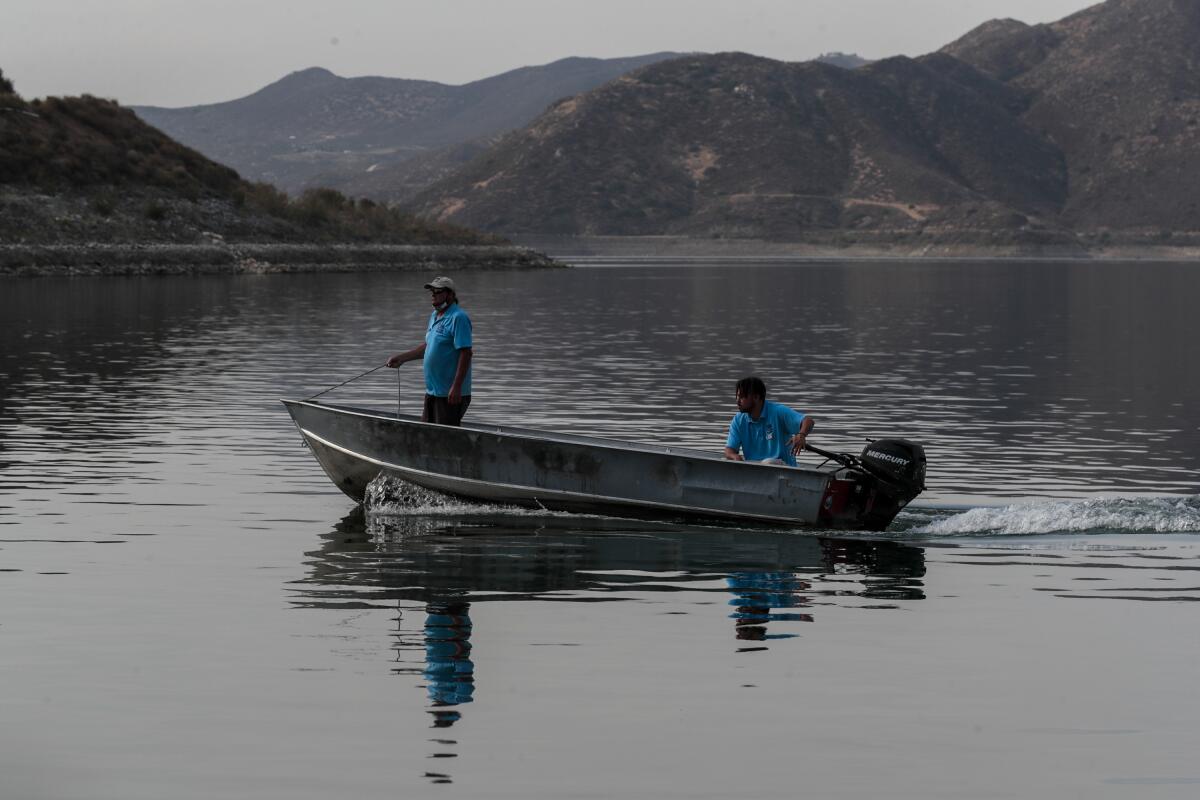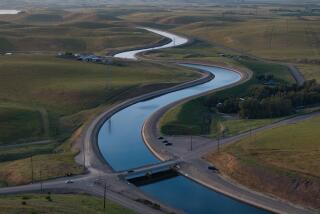Editorial: Recall candidates have shallow takes on California’s water problems

California is suffering from extremely dry conditions, so it stands to reason that the candidates trying to oust and replace Gov. Gavin Newsom have latched onto persistent but extremely shallow and woefully outdated claims about the management of the state’s water supply.
Their argument is that without Newsom (or indeed any Democrat) in the governor’s mansion, we’d have more dams, fewer wildfires, greener fields, longer showers, lusher lawns and as much pure, cool drinking water as we could possibly handle.
The irony is that Newsom has actually been fairly strong in support of agriculture and fairly weak on the environment, resulting in a lot of grumbling among advocates for fish and others in the environmental community — so much so that many talk about sitting this election out, because after all, how much worse would a Larry Elder or a Kevin Faulconer be on water and the environment than Newsom?
To which we say: Are you serious? If the leading candidates actually believe the nonsense they are spouting about California water and if one of them is elected and follows through on his simplistic nostrums, it would spell disaster for the state. Yes, environmentalists, a bigger disaster than the state is facing now. Far bigger.
Most of the proposed post-Newsom water reforms are tired talking points rooted in the 1970s, an era in which population growth and expanding farm acreage were deemed net benefits, and human-caused climate change was as yet unfelt and unknown. Some of the candidates at least acknowledge that we are heating the planet and altering climate patterns, yet their water policies remain tied to a half-century-old understanding of reality.
And some of their positions are not just outdated but deluded — like Assemblyman Kevin Kiley’s claim that droughts are “entirely avoidable” and that nature has absolutely nothing to do with water shortages. No, not even now, with a shockingly diminished Sierra snowcap, and ground that is so dry that it sucks up melting snow, leaving little runoff to fill lakes and streams. And not even with Lake Mead (the source of much of Southern California’s water) at its lowest level since Hoover Dam was dedicated in 1935.
This is an old line: Droughts are fake, water shortages are human inventions. President Trump didn’t invent this viewpoint, but it was a natural for him and he famously ran with it in 2016 during his campaign because it was embraced by the Central Valley counties economically dominated by agriculture.
Broken down into its components, the argument includes the assertion that after the construction of New Melones Dam on the Stanislaus River in the late 1970s, California lost its mojo and never again built a new dam to keep up with the growing population and its needs. Perennial candidate John Cox, in particular, advances this claim.
This urban myth is undermined with every drink of water taken in L.A. or much of the rest of Southern California. Before coming out of our taps, much of our water was stored in Diamond Valley Lake, a reservoir near Hemet completed in 2003. Many Bay Area residents similarly drink (and farm fields irrigate) from Los Vaqueros reservoir, halfway between Walnut Creek and Tracy, completed in 1998 and on the drawing board for a major expansion.
We have indeed kept building water projects, mostly for people, as opposed to cows and almond trees. Newer projects should be, and generally are, judged by how much water they will yield, and for whom. Given the state’s hydrology and the simple facts about where water is and isn’t, that means more spreading grounds and restored flood plains to allow stormwater runoff in flood years to recharge groundwater, which has been over-pumped by agricultural interests. It means reclaiming and purifying more water from urban storm runoff and waste.
Lake Mead will not be full again in our lifetimes, because after prolonged drought and diversions for human needs, there is simply not enough flowing water to fill it. Responding to a water shortage by building more empty dams is kind of like responding to a money shortage by building more empty banks. Lack of supply and lack of storage are not the same thing.
And desalination? Sure, of course — where projects make sense, and where ratepayers reap the benefits. Many desalination projects are hampered not by any lack of engineering or willpower mojo, but by the intense energy demands and costs, and by financial shenanigans that put ratepayers on the hook for water they don’t need or want.
Another 20th century idea is to go far afield to capture and bring back water from somewhere else. Schemes have included dragging icebergs across the ocean, and the late Lyndon LaRouche’s plan to divert Alaska snowmelt to a canyon in the Rocky Mountains and then to California.
Kevin Paffrath, a leading Democrat running to replace Newsom, wants to pipe in water from the Mississippi River. You can admire the sheer audacity of the scheme and still note that the construction and management costs and environmental damage would be slighter, and the water yield greater, with targeted investments in developing stormwater and wastewater resources closer to home.
Still, Paffrath’s scheme isn’t completely out of character for a Democrat, few of whom have been the environmental puritans that Republicans delight in caricaturing. Environmental water advocates are no fans of U.S. Sen. Dianne Feinstein, whom they see as doing the bidding of Big Agriculture, or Gov. Jerry Brown, who pushed for two huge tunnels to direct Sacramento River water southward.
Their dislike of Newsom centers on his insistence on so-called “voluntary agreements” — talks
among agricultural water users, environmental advocates and regulators over acceptable levels of water running through rivers to sustain migratory fish. Those talks have so far resulted in numerous missed deadlines and delays, and no actual agreements.
Are Democrats, environmental advocates and other natural Newsom allies really so mad at the governor’s environmental policies that they’d prefer a governor with a water program based in climate denial and dam nostalgia? We’ll find out soon enough.
More to Read
A cure for the common opinion
Get thought-provoking perspectives with our weekly newsletter.
You may occasionally receive promotional content from the Los Angeles Times.










